DODGE CHALLENGER 2022 Vehicle Warranty
Manufacturer: DODGE, Model Year: 2022, Model line: CHALLENGER, Model: DODGE CHALLENGER 2022Pages: 200, PDF Size: 6.72 MB
Page 1 of 200
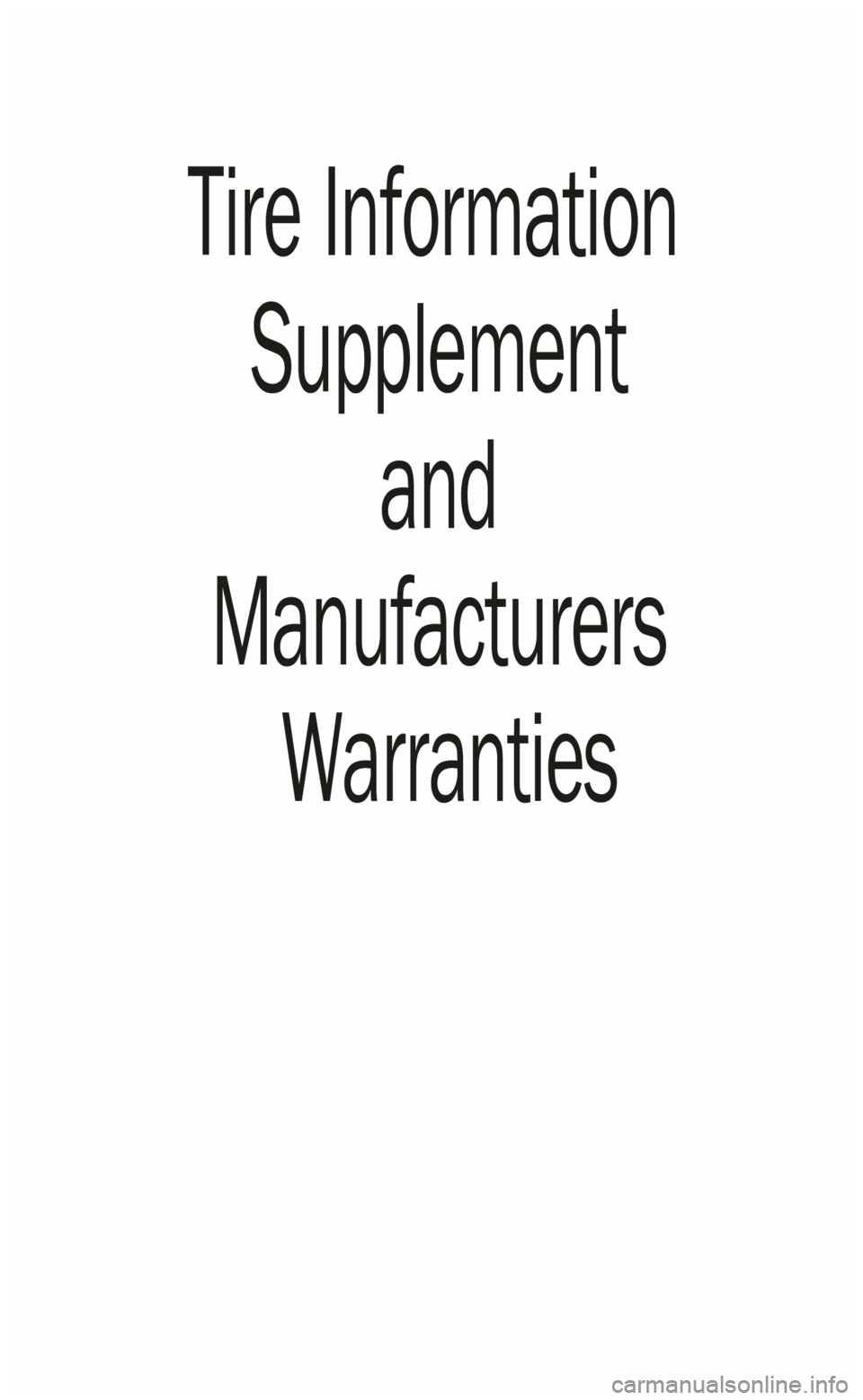
Tire
Information Supplement
and
Manufacturers Warranties
Page 2 of 200

TABLE OF CONTENTS
1
TIRES ..................................................................\
............2
DEPARTMENT OF TRANSPORTATION UNIFORM
TIRE QUALITY GRADES ...........................................18
TIRE WARRANTY ........................................................19
BFGOODRICH
® TIRES ...............................................21
BRIDG ESTONE
® - FIRESTONE® ...............................35
CONTINENTAL TIRE .................................................... 66
FALKEN TIRE CORPORATION
...................................72
GENERAL TIRE
............................................................ 87
GO
ODYEAR® DUNLOP® TIRES ................................92
HANKO OK TIRES
.......................................................104
KUMHO TIRES
...........................................................109
MICHELIN® ................................................................119
NEXEN TIRE ...............................................................
140
PIRELLI TIRES
........................................................... 148
TO
YO TIRES® – LIMITED WARRANTY ....................163
YOKOHAMA ®
TIRES — LIMITED W
ARRANTY ........194
Page 3 of 200
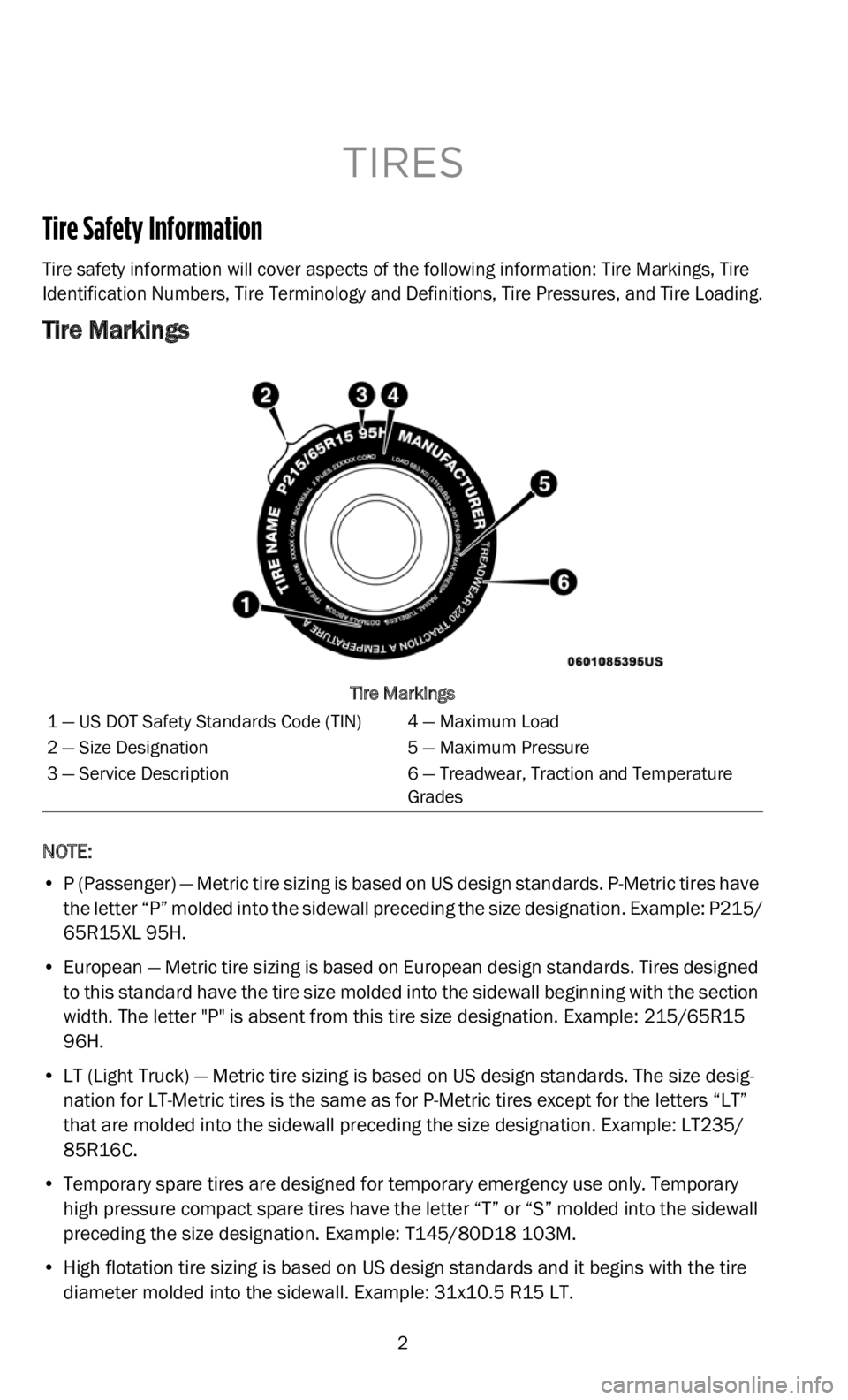
2
TIRES
Tire Safety Information
Tire safety information will cover aspects of the following information: Tire Markings, Tire
Identification Numbers, Tire Terminology and Definitions, Tire Pressures, and Tire Loading.
Tire Markings
Tire Markings
NOTE:
• P (Passenger) — Metric tire sizing is based on US design standards. P-Metric tires haveth
e letter “P” molded into the sidewall preceding the size designation. Example: P215/
65R15XL 95H.
• European — Metric tire sizing is based on European design standards. Tires designed to
this standard have the tire size molded into the sidewall beginning with the section
width. The letter "P" is absent from this tire size designation. Example: 215/65R15
96H.
• LT (Light Truck) — Metric tire sizing is based on US design standards. The size desig -
n a
tion for LT-Metric tires is the same as for P-Metric tires except for the letters “LT”
th a
t are molded into the sidewall preceding the size designation. Example: LT235/
85R16C.
• Temporary spare tires are designed for temporary emergency use only. Temporary hi
gh pressure compact spare tires have the letter “T” or “S” molded into the sidewall
preceding the size designation. Example: T145/80D18 103M.
• High flotation tire sizing is based on US design standards and it begins with the tire di
ameter molded into the sidewall. Example: 31x10.5 R15 LT.
1 — US DOT Safety Standards Code (TIN) 4 — Maximum Load
2 — Size Designation 5 — Maximum Pressure
3 — Service Description 6 — Treadwear, Traction and Temperature
Gra
des
Page 4 of 200

TIRES
3
Tire Sizing Chart
EXAMPLE:
Example Size Designation: P215/65R15XL 95H, 215/65R15 96H, LT235/85R16C,
T1 4
5/80D18 103M, 31x10.5 R15 LT
P = Passenger car tire size based on US design standards, or
"....blank...." =
Passenger car tire based on European design standards, or
LT = Light Truck tire based on US design standards, or
T
or S = Temporary spare tire or
3 1 =
Overall diameter in inches (in)
2 1
5, 235, 145 =
Section width in millimeters (mm)
65, 85, 80 = Aspect ratio in percent (%)
• Ra
tio of section height to section width of tire, or 10
.5 = Section width in inches (in)
R = Construction code
• "R" means radial construction, or
• "D
" means diagonal or bias construction
1 5
, 16, 18 = Rim diameter in inches (in)
S e
rvice Description:
95 = Load Index
• A
numerical code associated with the maximum load a tire can carry
H
= Speed Symbol
• A symbol indicating the range of speeds at which a tire can carry a load corre -
s p
onding to its load index under certain operating conditions
• The maximum speed corresponding to the speed symbol should only be achieved un
der specified operating conditions (i.e., tire pressure, vehicle loading, road condi -
tions, and posted speed limits)
Load Identification:
Absence of the following load identification symbols on the sidewall of the tire
in d
icates a Standard Load (SL) tire:
• XL = Extra load (or reinforced) tire, or
• LL =
Light load tire or
• C, D, E, F, G =
Load range associated with the maximum load a tire can carry at a
specified pressure
Maximum Load –
Maximum load indicates the maximum load this tire is designed to
carry
Maximum Pressure –
Maximum pressure indicates the maximum permissible cold tire
inflation pressure for this tire
Page 5 of 200

TIRES
4
Tire Identification Number (TIN)
The TIN may be found on one or both sides of the tire; however, the date code may only
be on one side. Tires with white sidewalls will have the full TIN, including the date code,
located on the white sidewall side of the tire. Look for the TIN on the outboard side of
black sidewall tires as mounted on the vehicle. If the TIN is not found on the outboard
side, then you will find it on the inboard side of the tire.
Tire Terminology And Definitions
EXAMPLE:
DOT MA L9 ABCD 0301
DOT = Department of Transportation
• Th
is symbol certifies that the tire is in compliance with the US Department of Trans -
p o
rtation tire safety standards and is approved for highway use
MA = Code representing the tire manufacturing location (two digits)
L9
= Code representing the tire size (two digits)
ABCD = Code used by the tire manufacturer (one to four digits)
03 =
Number representing the week in which the tire was manufactured (two digits)
• 03 m
eans the 3rd week
01 = Number representing the year in which the tire was manufactured (two digits)
• 01 m
eans the year 2001
• Prior to July 2000, tire manufacturers were only required to have one number to
re
present the year in which the tire was manufactured. Example: 031 could repre -
sent the 3rd week of 1981 or 1991
Term Definition
B-pillar The vehicle B-pillar is the structural member of the body
l
o c
ated behind the front door.
Cold Tire Inflation Pressure Cold tire inflation pressure is defined as the tire pressure
af
t
er the vehicle has not been driven for at least three
hours, or driven less than 1 mile (1.6 km) after sitting for
a m
inimum of three hours. Inflation pressure is
measured in units of psi (pounds per square inch) or kPa
(kilopascals).
Maximum Inflation Pressure The maximum inflation pressure is the maximum
p
e
r
missible cold tire inflation pressure for this tire. The
maximum inflation pressure is molded into the sidewall.
Page 6 of 200
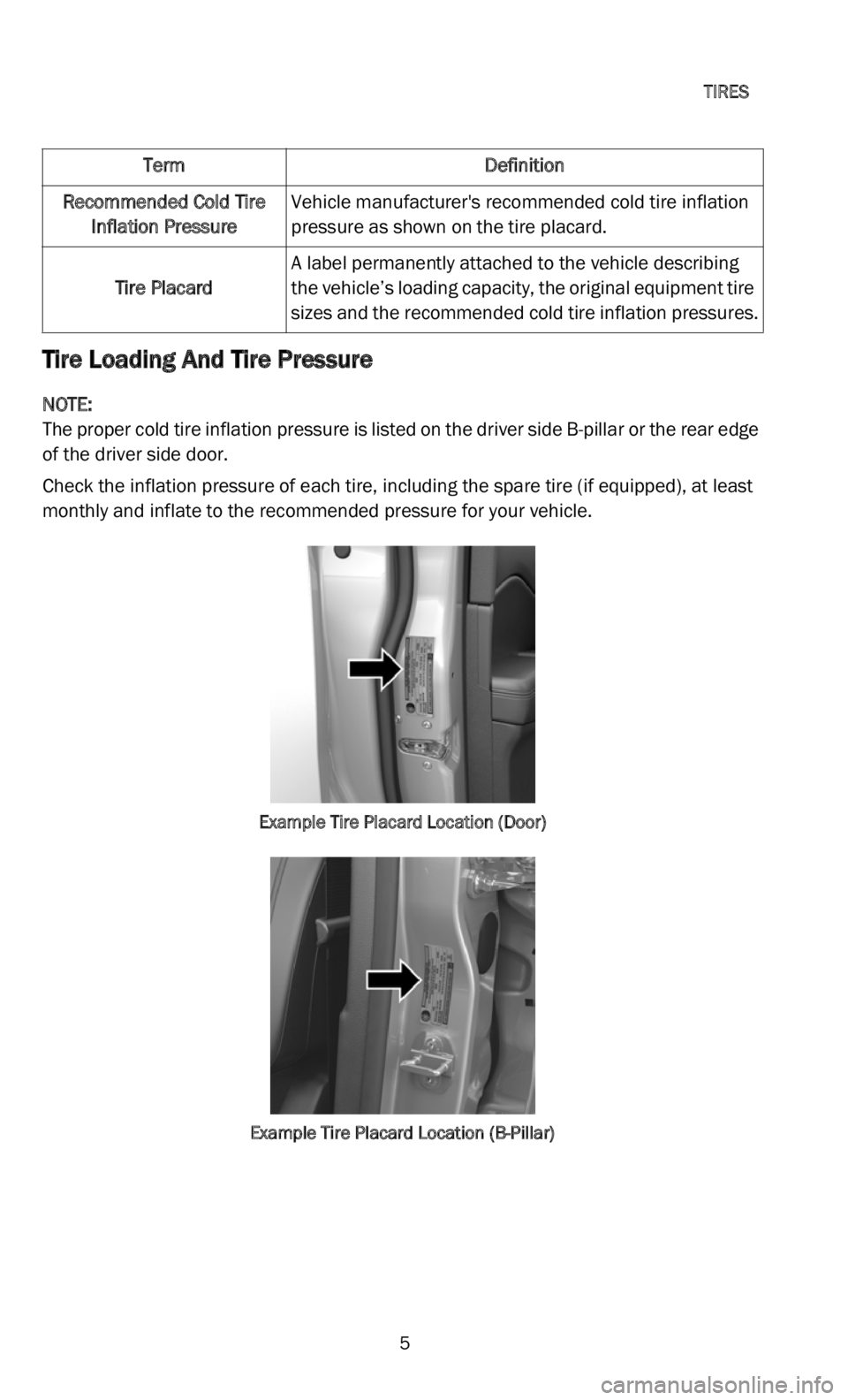
TIRES
5
Tire Loading And Tire Pressure
NOTE:
The proper cold tire inflation pressure is listed on the driver side B-pillar or the rear edge
of
the driver side door.
Check the inflation pressure of each tire, including the spare tire (if equipped), at least
mo n
thly and inflate to the recommended pressure for your vehicle.
Example Tire Placard Location (Door)
Example Tire Placard Location (B-Pillar)
Recommended Cold Tire Inflation Pressure Vehicle manufacturer's recommended cold tire inflation
pre
ssure as shown on the tire placard.
Tire Placard A label permanently attached to the vehicle describing
th
e
vehicle’s loading capacity, the original equipment tire
sizes and the recommended cold tire inflation pressures.
Term Definition
Page 7 of 200
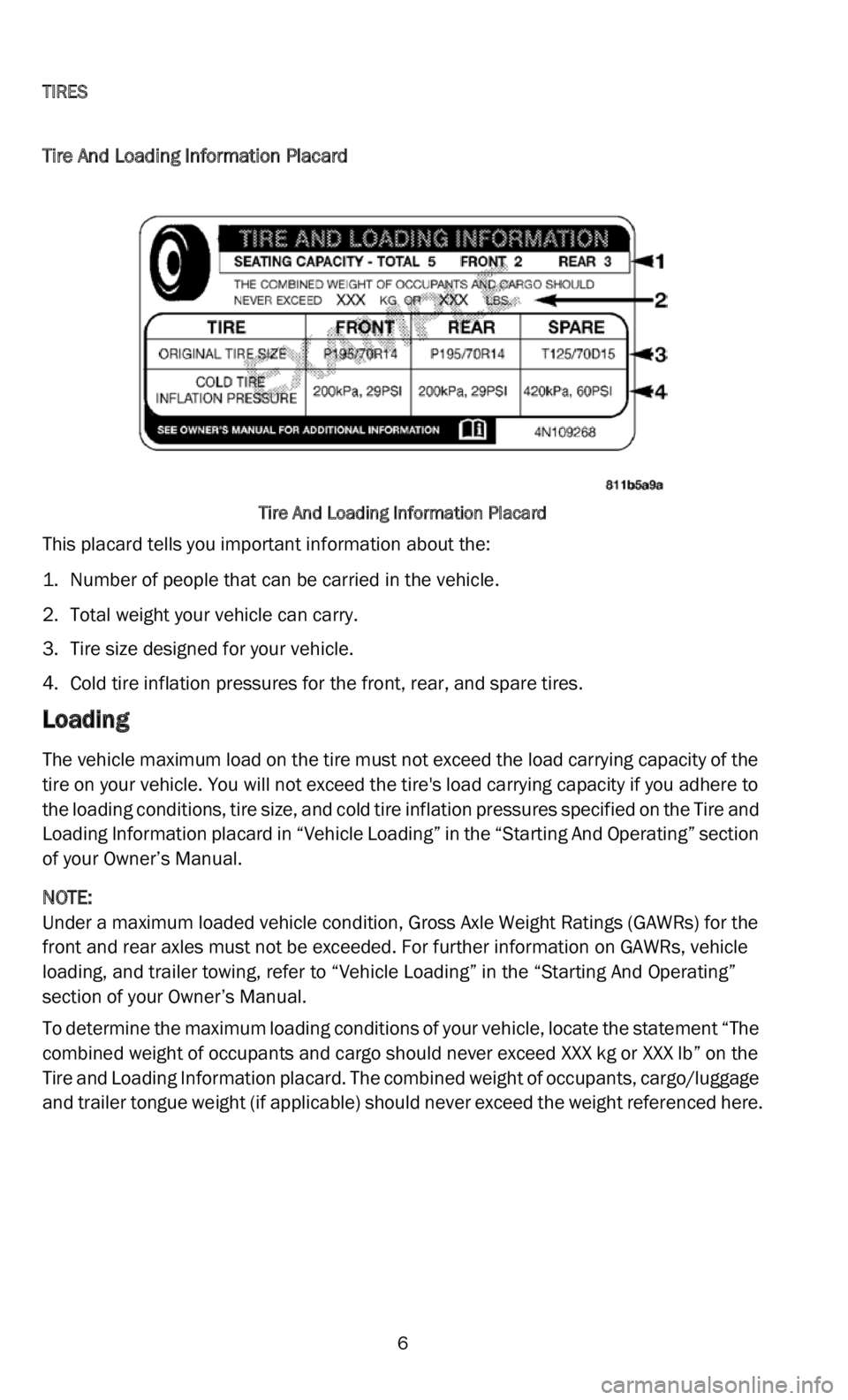
TIRES
6
Tire And Loading Information Placard
Tire And Loading Information Placard
This placard tells you important information about the:
1. Number of people that can be carried in the vehicle.
2.
Total weight your vehicle can carry.
3 .
Tire size designed for your vehicle.
4 .
Cold tire inflation pressures for the front, rear, and spare tires.
Loading
The vehicle maximum load on the tire must not exceed the load carrying capacity of the
tire on your vehicle. You will not exceed the tire's load carrying capacity if you adhere to
the loading conditions, tire size, and cold tire inflation pressures specified on the Tire and
Loading Information placard in “Vehicle Loading” in the “Starting And Operating” section
of your Owner’s Manual.
NOTE:
Under a maximum loaded vehicle condition, Gross Axle Weight Ratings (GAWRs) for the
f r o
nt and rear axles must not be exceeded. For further information on GAWRs, vehicle
loading, and trailer towing, refer to “Vehicle Loading” in the “Starting And Operating”
section of your Owner’s Manual.
To determine the maximum loading conditions of your vehicle, locate the statement “The
co m
bined weight of occupants and cargo should never exceed XXX kg or XXX lb” on the
Tire and Loading Information placard. The combined weight of occupants, cargo/luggage
and trailer tongue weight (if applicable) should never exceed the weight referenced here.
Page 8 of 200

TIRES
7
Steps For Determining Correct Load Limit—
(1) Locate the statement “The combined weight of occupants and cargo should never
ex c
eed XXX kg or XXX lb” on your vehicle's placard.
(2) Determine the combined weight of the driver and passengers that will be riding in
yo u
r vehicle.
(3) Subtract the combined weight of the driver and passengers from XXX kg or
XXX lb.
(4) The resulting figure equals the available amount of cargo and luggage load capacity.
Fo r
example, if “XXX” amount equals 1,400 lb and there will be five 150 lb passengers
in your vehicle, the amount of available cargo and luggage load capacity is 650 lb
(1,400-750 (5x150) = 650 lb).
(5) Determine the combined weight of luggage and cargo being loaded on the vehicle.
Th a
t weight may not exceed the available cargo and luggage load capacity calculated in
Step 4.
(6) If your vehicle will be towing a trailer, the load from your trailer will be transferred to
yo u
r vehicle. Consult this manual to determine how this reduces the available cargo and
luggage load capacity of your vehicle.
Metric Example For Load Limit
For example, as shown in step 4 above, if “XXX” amount equals 635 kg and there will be
fi v
e 68 kg passengers in your vehicle, the amount of available cargo and luggage load
capacity is 295 kg (635-340 (5x68) = 295 kg).
NOTE:
• If your vehicle will be towing a trailer, the load from your trailer will be transferred to yo
ur vehicle. The following table shows examples on how to calculate total load,
cargo/luggage, and towing capacities of your vehicle with varying seating configura -
tions and number and size of occupants. This table is for illustration purposes only and
ma y
not be accurate for the seating and load carrying capacity of your vehicle.
• For the following example, the combined weight of occupants and cargo should never ex
ceed 865 lb (392 kg).
Page 9 of 200
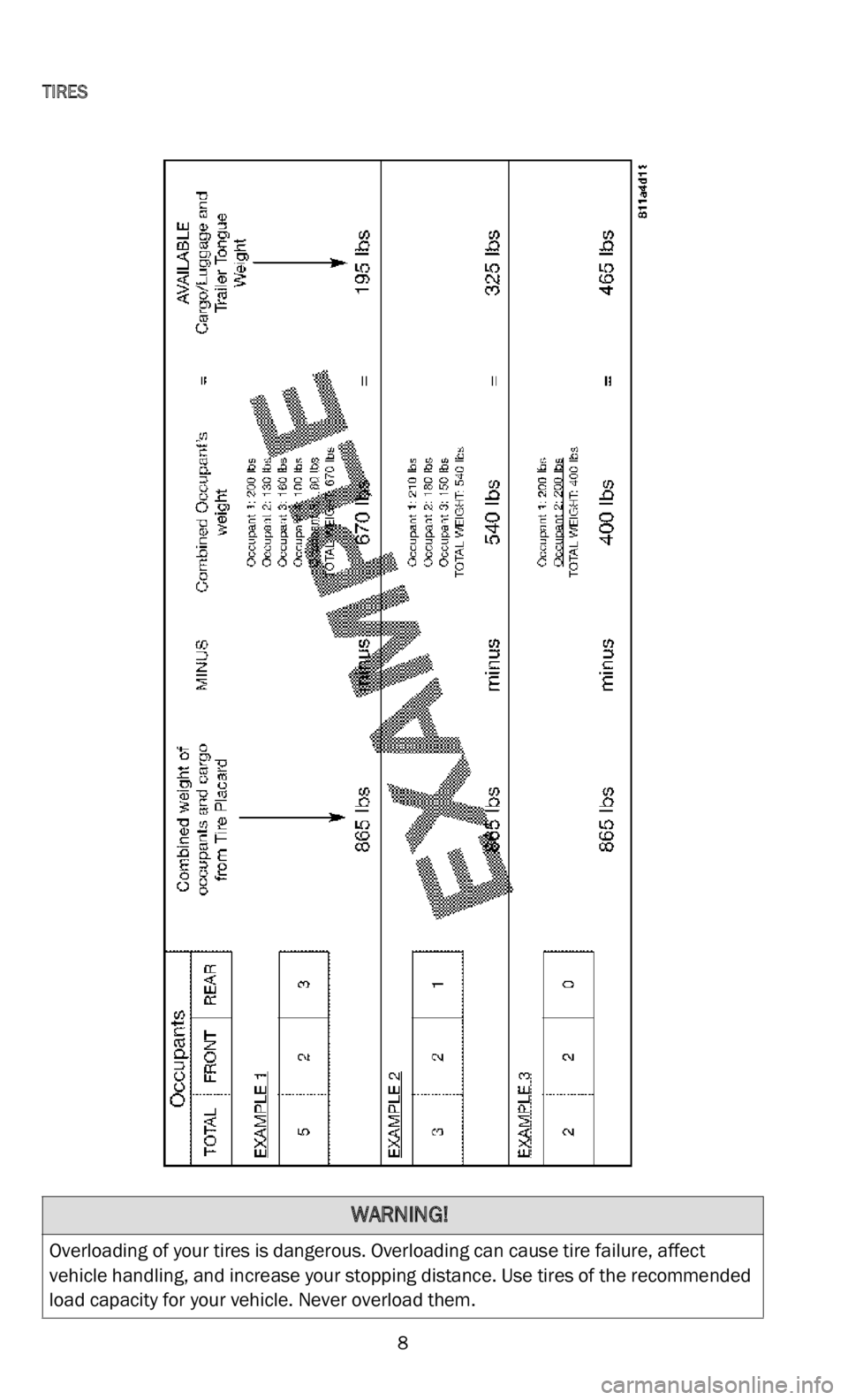
TIRES
8
WARNING!
Overloading of your tires is dangerous. Overloading can cause tire failure, affect
vehicle handling, and increase your stopping distance. Use tires of the recommended
load capacity for your vehicle. Never overload them.
Page 10 of 200

TIRES
9
Tires — General Information
Tire Pressure
Proper tire inflation pressure is essential to the safe and satisfactory operation of your
vehicle. Four primary areas are affected by improper tire pressure:
• Safety and Vehicle Stability
• Ec
onomy
• Tr
ead Wear
• Ri
de Comfort
S a
fety
Both underinflation and overinflation affect the stability of the vehicle and can produce
a f
eeling of sluggish response or over responsiveness in the steering.
NOTE:
• U nequal tire pressures from side to side may cause erratic and unpredictable steering
r e
sponse.
• Unequal tire pressure from side to side may cause the vehicle to drift left or right.
F u
el Economy
Underinflated tires will increase tire rolling resistance, resulting in higher fuel
co n
sumption.
WARNING!
• Improperly inflated tires are dangerous and can cause collisions.
• Underinflation increases tire flexing and can result in overheating and tire failure.
•Ov
erinflation reduces a tire's ability to cushion shock. Objects on the road and chuck -
h o
les can cause damage that result in tire failure.
• Overinflated or underinflated tires can affect vehicle handling and can fail suddenly, re
sulting in loss of vehicle control.
• Unequal tire pressures can cause steering problems. You could lose control of your ve
hicle.
• Unequal tire pressures from one side of the vehicle to the other can cause the ve
hicle to drift to the right or left.
• Always drive with each tire inflated to the recommended cold tire inflation pressure.